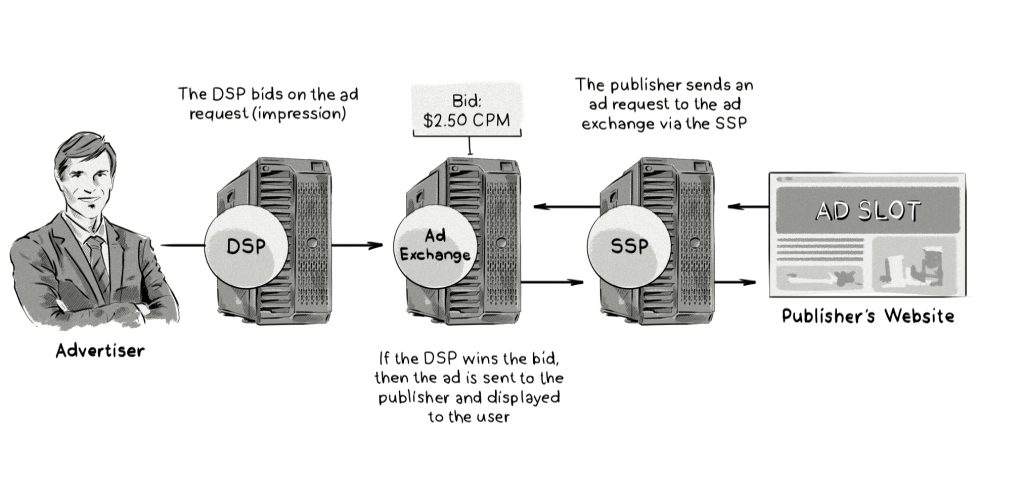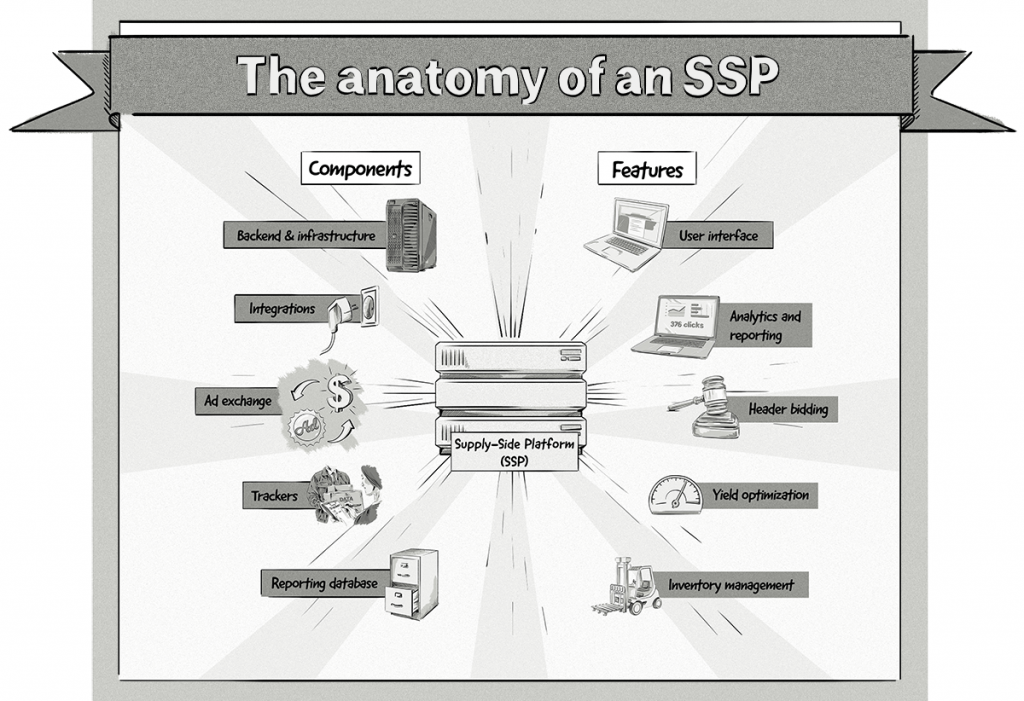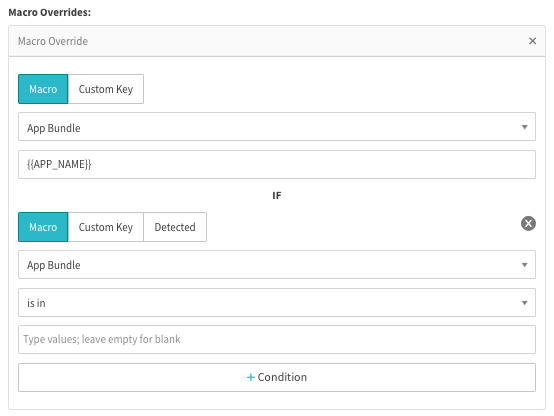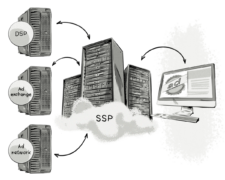Supply-side platforms (SSPs) empower publishers to monetize their ad inventory and maximize their ad revenue potential. The software connects publishers with multiple ad exchanges, demand-side platforms, and ad networks, enabling them to sell their advertising impressions to a broader pool of potential buyers and helping them to understand audience insights deeply.
To understand better what other benefits an SSP can bring, we dive deep into the key features of a supply-side platform.
Key Points
- A supply-side platform (SSP) is an advertising technology platform that enables publishers to manage, sell, and optimize their available ad inventory on websites, mobile apps and other digital advertising channels.
- To connect publishers with buyers, SSPs integrate with various demand sources, such as DSPs, ad exchanges, ad networks, and agencies.
- Critical features in an SSP are yield optimization, integrations with demand sources, ad quality controls, header bidding, analytics and reporting, budgeting, frequency capping, and inventory and campaign management.
What Is a Supply-Side Platform (SSP)?
A supply-side platform (SSP) is an advertising technology platform that enables the management, sale, and optimization of publishers’ available inventory on websites and mobile apps. By leveraging SSPs, publishers can tap into real-time bidding (RTB) media transactions, selling display, video, and native ad space to advertisers on an impression-by-impression basis.
Publishers use SSPs to streamline ad operations and maximize their efficiency and revenue potential.
We Can Help You Build a Supply-Side Platform (SSP)
Our AdTech development teams can work with you to design, build, and maintain a custom-built supply-side platform (SSP) for any programmatic advertising channel.
How Does a Supply-Side Platform (SSP) Work?
SSPs have several options for selling a publisher’s inventory. The most popular one, though, is through real-time bidding (RTB) auctions.
The illustration below shows the selling process of ad space with an SSP via RTB.

Here’s an explanation of how an SSP works using real-time bidding:
- A publisher defines and organizes their available ad space, including formats (display, video, native), ad sizes, and targeting options.
- Each time the publisher’s webpage loads, an ad request is sent to multiple ad exchanges and sometimes straight to demand-side platforms, either directly from the webpage to an SSP or from the publisher’s ad server to an SSP.
- Various DSPs would make bids on the impression that the publisher was offering (as seen in the graphic above).
- The winning bid is then sent back to the website, where the ad is shown to the user.
Key Features of an SSP
When choosing or building an SSP, it is essential to determine the key features that will meet a company’s specific use cases. Below we’ve listed the main SSP functionalities that help effectively manage and optimize programmatic advertising operations.

User Interface
Publishers utilize the user interface to manage campaigns, examine reports, handle payments, and access other SSP capabilities.
The user interface is critical to operating the SSP in an easy and comfortable way.
Analytics
Comprehensive analytics capabilities are essential for publishers to gain insights into their ad performance and make data-driven decisions.
SSPs provide detailed reports on key metrics such as:
- Impressions
- Clicks
- Revenue
- Fill rates.
Publishers can leverage these insights to optimize their ad strategies, identify revenue opportunities, and evaluate the effectiveness of their inventory monetization efforts.
Reporting
Publishers can obtain information from SSPs about who is bidding, the price at which their inventory is being purchased, and the amount paid by specific advertisers. This provides deeper perceptions of the value of their inventory for particular advertisers.
Custom Reporting
The custom reporting module allows AdOps to generate tailor-made reports that align precisely with specific requirements.
Within the reporting module, various typical settings come into play, such as:
- The selection of pre-saved templates.
- The determination of fixed or dynamic periods.
- The choice of aggregation periods.
- The specification of time zones.
- The selection of metrics and dimensions.
- The application of filters.
Custom reporting modules often include visually appealing charts to enhance the readability of information.
Live reporting
For analyzing data from recent events, AdOps can leverage live reporting. The feature is usually limited by predefined metrics and displays information up to three hours back and with a delay time between the newest and present data of up to one minute.
The module of live reporting also is visually appealing, as the information is shown on charts and in tables.
Header Bidding
Header bidding (HB) allows publishers to offer their inventory to multiple demand sources simultaneously before making the ad call to the ad server. The SSP collects the bids from the demand sources, typically via Prebid, and evaluates them based on factors such as bid price, targeting parameters, ad quality, and publisher preferences.
The highest bid is selected as the winning bid, and the ad associated with that bid is served to the user. Most SSPs incorporate this feature as they want to maximize revenue for their clients (i.e. publishers).
The benefits of the header bidding in SSPs include:
- Increased revenue as they can pick the best bid.
- Improved fill rates as they sell more ad space.
- More insights as HB provides publishers with bid prices and demand source performance.
The header-bidding feature of an SSP enables publishers to manage their various header-bidding wrappers and demand partners from one user interface.
If you want to learn more about header bidding development, i.e., wrappers, adapters, and reporting and analytics tools, view our presentation and read Q&A With an AdTech Developer: How To Implement Prebid Server.
Yield Optimization
Yield optimization is a variable pricing strategy that uses data analysis and other optimization methods to improve fill rates and sell impressions (CPM) at the highest possible price. For that matter, yield optimization utilizes the following:
- Data analysis,
- Floor prices optimization mechanics,
- Fill rates management,
- First- and second-price auctions.
The feature considers factors such as historical performance, audience behavior, market trends, and advertiser demand.
Ad Quality Controls
Ad quality controls refer to various features inside SSPs, such as ad verification, content categorization, and malware detection. Each of them has a different role and the same aim — to maintain safe ad serving for publishers. This means that proper ads are displayed to the proper audiences, ensuring brand integrity, improving user experience, and safeguarding from fraudulent or malicious ads.
Money lost on ad fraud is getting stronger, and at the end of 2023, it is predicted advertisers to lose $100 billions due to the activity of fraudsters.

Demand Source Integration
In order to allow publishers to connect with a diverse pool of potential buyers, SSPs need to integrate with demand-side platforms (DSPs), ad exchanges, ad networks, agencies, and direct advertisers. Developing communication protocols is a necessary step towards integrations with those multiple demand sources.
Here are the communication protocols utilized in the process of integration SSPs with other platforms:
- APIs.
- Server-to server integrations.
- Software development kits (SDKs).
- Tag-based integrations.
If you want to learn more about SSPs integrations, read our previous blog post How to Integrate a DSP with Ad Exchanges and SSPs.
Budgeting
Budget settings in SSPs serve as a crucial tool for optimization. They enable AdOps to establish limits on traffic for connected publishers and demand sources.
For instance, AdOps can control the number of requests sent to each demand source based on received responses or revenue generated, ensuring an efficient ratio between revenue and cost.
Frequency Capping
Frequency capping in an SSP limits the number of ad impressions or requests that are passed onto the demand sources for a single user.
When applied to a publisher, it restricts how many times a particular ad is served to a specific visitor on a webpage within a certain period. This setting is often used for safety purposes when an excessive number of ad requests originate from the same user, but also to avoid showing the same user the same ad too many times in a row
Alternatively, when frequency capping is implemented for a demand source, it controls how frequently that source can win an ad request for the same visitor.
This does not limit the overall traffic from the visitor, but it prevents a single demand source from winning too many ad requests from the same user within a certain period.
Consequently, this promotes a more diverse distribution of responses from various demand sources as the DSP for the capped demand source would simply not return a bid response once the limit has been reached.
Ad Targeting
To filter out incoming requests with specific criteria, different targeting options are used. For example, certain demand sources don’t want to take part in auctions for visitors from the EU, so it would be a waste of resources to send such requests to this demand source.
Examples of targeting criteria include:
- Domain
- Appbundle
- App name
- IP
- Country/Region
- Ad size
- Ad type
- Video formats/sizes
- Device
- OS
- Browser
- Content
- key-values
Customizable Macro Support and Override
SSPs often need to deal with a variety of systems, and these systems sometimes don’t align perfectly. This inconsistency can cause AdOps teams some difficulty.
For this reason, SSP should be able to manually adjust incoming values from supply sources before they are transmitted to the demand side. This means AdOps teams can change certain parameters, like the app bundle or app name, ensuring the most accurate data is passed on.
Another useful aspect of this feature is the ability to define the structure of query parameters on the endpoint URL directly within the user interface. This comes in handy when partners have different requirements. AdOps teams can place placeholders in the URL, which the system then fills with the appropriate values from incoming requests or defined values if overridden.

For instance, suppose an incoming call looks like this:
https://adserver-testing.com/vast/11111?w=[replace_me]&h=[replace_me]&cb=[replace_me]&ua=[replace_me]&uip=[replace_me]&app_name=[replace_me]&app_bundle=[replace_me]&d_model=[replace_me]&d_make=[replace_me]&app_store_url=[replace_me]&device_id=[replace_me]&vast_version=2
The feature allows AdOps to customize the URL as follows
https://tv.springserve.com/vast/99999?w=[WIDTH]&h=[HEIGHT]&cb=[CB]&ip=[IP]&ua=[UA]&app_bundle=[APP_BUNDLE]&app_name=[APP_NAME]&app_store_url=[APP_STORE_URL]&did=[DEVICE_ID]&us_privacy=[US_PRIVACY]&schain=[SCHAIN]
The system will replace the placeholders ([WIDTH], [HEIGHT], etc.) with relevant incoming or defined values, making it much easier to manage ad serving and to meet various partners’ needs.
Inventory and Campaign Management and Optimization
With these features, publishers can gain comprehensive control over their diverse inventory types, including display, video, native, and more. They can easily manage advertiser blacklists and whitelists, set specific IAB categories, and efficiently block undesirable types of ads.
Inventory optimization helps extract maximum value from an available inventory or individual ad slots.
However, the absence of universal rules requires a nuanced approach, with AdOps experimenting with specific settings tailored to each unique supply-demand connection.
What settings can be optimized?
- Floor price
- Metrics-based optimizations, such as:
- Opportunity fill vs. request fill
- Score
- Response time
- Fill speed
- Score speed
- Opportunity score
- Opportunity fill speed
What’s the Difference Between an SSP and an Ad Exchange?
Ad exchanges and SSPs collaborate closely, yet they serve different purposes. DSPs and SSPs can work on media transactions through ad exchanges.
The majority of SSPs nowadays do have exchange mechanisms, though, so DSPs may integrate with them directly and buy inventory through RTB auctions. The OpenRTB protocol is used to establish this DSP-SSP connection as well as connections between SSPs, ad exchanges and DSPs.
What Is the Difference Between a Supply-Side Platform and a Demand-Side Platform?
Both platforms operate within the digital landscape. However, they serve different purposes for different groups of users.
A supply-side platform is used by publishers to manage and monetize their ad inventory. It enables publishers to connect with multiple demand sources, such as DSPs, ad networks, and ad exchanges, to sell their advertising inventory.
A demand-side platform is utilized by advertisers and agencies to purchase ad inventory across various publishers and ad exchanges. DSPs allow advertisers to manage their campaigns, target specific audiences, and optimize their ad spend through real-time bidding and programmatic buying.
The table below displays the main differences between the two platforms.

We Can Help You Build a Supply-Side Platform (SSP)
Our AdTech development teams can work with you to design, build, and maintain a custom-built supply-side platform (SSP) for any programmatic advertising channel.








